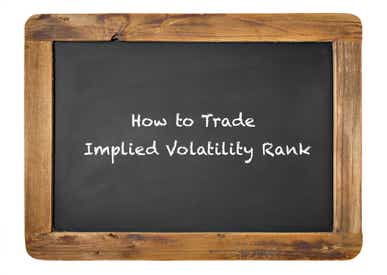A New Way to Trade Implied Volatility

A New Way to Trade Implied Volatility
IV has been low for a long time, prompting some to view IVRs as low as 20 or 30 as opportunities
Implied volatility rank (IVR) gives traders a stock-specific way to trade implied volatility.
IVR measures a stock’s implied volatility (IV) over the last year, showing where IV sits in the distribution of IVs for that stock.
Using IVR, traders can play volatility mean reversion in a more sophisticated way, selling high IVR and buying low IVR.
Many traders approach the market with a directional bias, and they keep their approach to generating profits simple. If the market moves in their favor, they make money. If the market moves against them, they lose money. And while having a directional bias is something almost every trader can relate to, there is an altogether different way to build your portfolio and begin putting on positions with implied volatility (IV).
And they can do it even more specifically with implied implied volatility rank (IVR).
What is implied volatility rank?
While IV is one of the inputs into the Black-Scholes model and gives some indication of the anticipated range of a stock, IVR actually measures the IV of a given stock against itself over the previous 12 months. The output gives us a sense of where that individual stock’s IV sits in the distribution of its own range of IVs over the last year.
It reads much like the scores of a standardized test. If a stock’s IVR is 20, that tells you its current IV is in the 20th percentile of all of its IVs over the last year—so relatively low. If, however, a stock’s IVR is 75, that tells me that its current IV is in the 75th percentile of all of its IVs over the last twelve months—so relatively high. Viewing the IV of a specific stock through the lens of IVR yields insight into potential trades aimed at taking advantage of volatility mean reversion.
How to trade implied volatility rank
Given market volatility’s tendency to mean revert, we know we want to sell high volatility and buy low volatility. But with IVR, we get even more sophisticated with that approach—looking to sell high IVR and buy low IVR. That way, you’re not only trading volatility mean reversion in a general sense, but you’re able to dial in your entry for a specific stock, given its own history of volatility. Doing this adds a new layer of volatility analysis that helps position your long premium trades when volatility is low and your short premium trades with volatility is high.
Now, of course, the million dollar question is: What is a high IVR and what is a low IVR? Certainly, you can keep things simple,and classify anything above the midpoint of the distribution (50 IVR) as a higher IVR, and anything below the midpoint of the distribution as a lower IVR. But given that market volatility has been on the lower end for quite some time now, many volatility traders look at IVRs as low as 20 or 30 as relatively “high” in this market, and could still represent opportunities for short premium.
Jim Schultz, a quantitative expert and finance Ph.D., has been trading the markets for nearly two decades. He hosts From Theory to Practice, Monday-Friday on tastylive, where he explains theoretical trading concepts and provides a practical application of those concepts to a trading portfolio. @jschultzf3
For live daily programming, market news and commentary, visit tastylive or the YouTube channels tastylive (for options traders), and tastyliveTrending for stocks, futures, forex & macro.
Trade with a better broker, open a tastytrade account today. tastylive, Inc. and tastytrade, Inc. are separate but affiliated companies.
Options involve risk and are not suitable for all investors. Please read Characteristics and Risks of Standardized Options before deciding to invest in options.